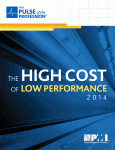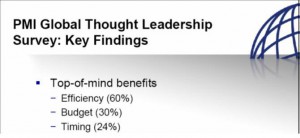This year again the Project Management Institute (PMI), being a leading professional institutions in project management, continues its research series with the actual report “The Pulse of the Profession”.
This time the study’s and findings’ focus ist hat enterprises which consequently live the fundamental basics of project management achieve significantly better results in business as well.
 Those basics include:
Those basics include:
- Fully understanding the value of project management
- Having actively engaged executive sponsors
- Aligning projects to strategy
- Developing and maintaining project management talent
- Establishing a well-aligned and effective PMO (project management office)
- Using standardized project management practices such as Risk Management, Knowledge Transfer, use of agile/incremental/iterative practices in project management and benefits realtzation maturity throughout the organization
Such companies, called “High Performers” in the report, have 2 1/2 times more projects fully meeting their original goals than less mature organizations, and they waste 13 times less money !
But besides this main result it needs to be noticed that the number of “High Performers” remains steady at only 12 percent. Laila MT Faridoon, Director of the Chairman’s Office at Roads and Transport Authority (RTA) therefore assumes: “I believe more focus on selling the concept of OPM (= Organizational Project Management) and its value to the C-suite is essential to cause a noticeable change.” Thus good project management and a mature PM organization keeps on being matter of the boss , and without acknowledgement of its value by the top management businesses will go on stagnating “low performing”.
But read it yourself. Find the actual PMI report “The Pulse of the Profession 2015” for download here or directly at PMI at http://www.pmi.org/learning/pulse.aspx

 It’s not astonishing the the report sub-titles this year again “The high Cost of low Performance“, because the statistic rate of projects that miss their schedule, cost or benefit objectives partly or totally, unfortunately has nearly remained at the same high level as last year.
It’s not astonishing the the report sub-titles this year again “The high Cost of low Performance“, because the statistic rate of projects that miss their schedule, cost or benefit objectives partly or totally, unfortunately has nearly remained at the same high level as last year. The case:
The case: onsite at the customer without having real competences and access to resources. Sales, driven by commission interests, often threw badly cleared orders and unrealistic delivery promises over the fence at the projects. At the installation sites, in particular with international orders, regional sales interests, mentality or working habits frequently spoiled fulfilment to plan. Suppliers and customers often had a weak organizational maturity to achieve provisions as planned. Thus many projects were “deeply red” already at order confirmation; the involved units’ own lives prevented from targeted project management, and their individual striving for profit made an overall optimization of project margins impossible.
onsite at the customer without having real competences and access to resources. Sales, driven by commission interests, often threw badly cleared orders and unrealistic delivery promises over the fence at the projects. At the installation sites, in particular with international orders, regional sales interests, mentality or working habits frequently spoiled fulfilment to plan. Suppliers and customers often had a weak organizational maturity to achieve provisions as planned. Thus many projects were “deeply red” already at order confirmation; the involved units’ own lives prevented from targeted project management, and their individual striving for profit made an overall optimization of project margins impossible. If you look at the causes it’s not technical (6%) and resource (9%) issues holding the top ranks, but rather insufficient project management (16%) and lacking management and organization support (18%). Additionally in most cases there are unclear requirements and stakeholders‘ goals (12%), and bad communication (15%) among the involved parties incl. the management.
If you look at the causes it’s not technical (6%) and resource (9%) issues holding the top ranks, but rather insufficient project management (16%) and lacking management and organization support (18%). Additionally in most cases there are unclear requirements and stakeholders‘ goals (12%), and bad communication (15%) among the involved parties incl. the management.

 I had the general manager consider that he had calculated the effort of project management too low, and I offered to conduct a Project Health Check for free after a half year of the project’s course.
I had the general manager consider that he had calculated the effort of project management too low, and I offered to conduct a Project Health Check for free after a half year of the project’s course. Science and management still need to realize and acknowledge that besides manageing the daily business there is another, meanwhile similarly important area of leadership which, by investments and initiatives (= projects and programmes) prepares and adapts the company to the market requirements and future. Then there is a chance that the added value deriving from this area is valued appropriately enough to be managed as professionally as the running business, and thus is able to achieve better success ratios and meet targets better than it is until now.
Science and management still need to realize and acknowledge that besides manageing the daily business there is another, meanwhile similarly important area of leadership which, by investments and initiatives (= projects and programmes) prepares and adapts the company to the market requirements and future. Then there is a chance that the added value deriving from this area is valued appropriately enough to be managed as professionally as the running business, and thus is able to achieve better success ratios and meet targets better than it is until now.